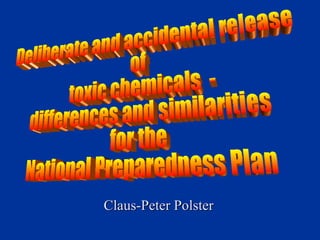
Differences and similarities between deliberate and accidental toxic chemical releases
- 1. Claus-Peter Polster Deliberate and accidental release of toxic chemicals - differences and similarities for the National Preparedness Plan
- 15. Deliberate or accidental ? Different or similiar ? Source (Intent) Substance (Hazard) Dissemination (Magnitude) Response (Control & Mitigation) Targets (Vulnerability) Recovery
- 21. 1 10 20 100 200 Chlorine Cyanogen Chloride Phosgene Hydrogen Cyanide Mustard Sarin VX 600 RELATIVE LETHALITY IN RELATION TO CHLORINE (RESPIRATORY) 50ppm chlorine are potentially fatal even after short exposure 600x 200x 13x 7x 6x 2x
- 23. Chemical warfare without CW ? “ Gas is insidious. It often causes casualties without any warning. It exerts a tremendous effect on morale, especially in untrained troops. Uncertainty as to when and where gas is present and how it will act is demoralizing even to troops with high discipline. Nothing breaks a soldier’s will to fight so quickly as being gassed, even slightly. His imagination magnifies his real injury 100-fold.” Frederic Brown Chemical Warfare: A Study in Restraints . Princeton, NJ: Princeton University Press; 1968
- 24. Fatalities Injuries Atropine overdose Anxiety 2 224 230 544 18 January - 28 February 1991 Iraqi SCUD attacks on Israel
- 25. Fatalities Hospitalized Ambulant “ Non-Casualties” 4500 1000 12 200 20 March 1995
- 33. Questions ?
Editor's Notes
- Bad Münder 09/09/02 Epichlorhydrin 350 people medically treated